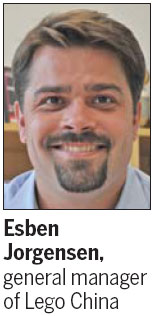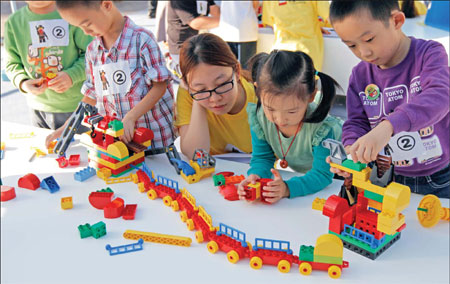Brick building for fun and fortune
Updated: 2012-12-07 09:06
By Zhao Yanrong (China Daily)
|
|||||||||||
|
Children play with Lego bricks during the Beijing Design Week in October. The Denmark-based toy maker is confident of strong growth in China. Provided to China Daily |
Europe's enduring favorite toy is just a youngster in China - but is growing up fast
Lego, acclaimed by Fortune Magazine and the British Association of Toy Retailers as the "toy of the century", has just turned 80 years old.
But in China this year, it is still acting like an energetic youngster, with its first Lego truck tour across the country, the biggest theme event on Children's Day and the opening in Beijing of its largest Lego experience store.
It has grown up fast. After an annual growth in sales volume of 45 percent from 2009 to 2011, Lego China saw sales in the first half of this year jump 75 percent. It expects to reach 80 percent by the end of the year.
"The growth is satisfying," says Esben Jorgensen, general manager of Lego China. "We became very confident based on the quick business development in China over the past two years, and we invested a lot of money this year to reach a much bigger achievement. We are ready for China, and China is ready for Lego."
 |
The company, however, would not release specific sales and investment figures for China.
Jorgensen's confidence is built on his faith in the Chinese market, which has seen a big growth of middle-class families and greater spending by a new generation of Chinese parents.
It is estimated that the size of Chinese middle-class is more than 300 million, larger than the entire population of the United States, and is one of the major forces driving Lego's business growth.
Although the toy assembly bricks and components of Lego are more expensive than similar Chinese brands, the product is comfortably affordable within family budgets. "Lego is a big brand, but not a luxury product," Jorgensen says.
The post-1980 generation of parents, Jorgensen believes, are more willing to spend money on their children, not only on their education, but also on building closer bonds with them through play.
When Li Chen, 30, was a little girl, the only toy she had was a doll with a broken leg, left to her by an elder cousin.
"I am happy to see my son has more options for play than I had in my childhood," she says. "Many of my friends and colleagues bought Lego for their children, and I made sure my son had it as well."
Li also trusts the quality of Lego in the hands of her 5-year-old son.
"There are some similar products that are only half the price, but I am worried that they use toxic material to make them."
Her biggest challenge is in joining with her child in playing with the toy.
"If my husband is not available to play with him, he sometimes just sprinkles the little bricks everywhere around the living room. I know it's not the real fun Lego is supposed to bring to kids."
So Li takes her son to the Lego experience store in Chaoyang Park in Beijing at least twice a month. The store occupies about 300 square meters, and almost two-thirds of the area is for customers to experience and play with the bricks and variety of modules. The store also runs seminars on how to build models.
Li learnt how to build an apartment block model at the store and now feels more confident about guiding and inspiring her son's play.
Chinese families like Li's, typical customers of Lego China, in turn provide a new challenge for the old, experienced hands of the famous toy company.
In the United States and European markets, rather than showing customers how to play with Lego, the approach is to share stories about how parents grew up with the colorful bricks.
"But we don't have that legacy in China," says Jorgensen. "That means as well as attracting the children's attention with our products, we also need to educate the parents."
But he believes it will take time to build the Lego culture in Chinese families, and the real boom in Lego "construction" in China will not happen for another 10 to 15 years.
"Chinese kids now are actually the first Lego generation in China, and when they become parents, they will see the bricks as a necessity for their children, and they can make the bricks more fun with the next generation, like we are experiencing in America," Jorgensen says.
A large-scale promotion of Lego's products is underway in China, through TV advertisements, social media and theme events. Lego China has also registered with Sina Weibo, China's answer to Twitter, and Kaixin, Facebook's Chinese equivalent, and expects to attract more than 400,000 Lego fans by the end of the year.
From four cities at the beginning of this year - Beijing, Guangzhou, Shanghai and Shenzhen - Lego China has targeted another 14 to expand its retail channels, including Xi'an, Dalian and Foshan.
Because 2013 is the Year of the Snake in the Chinese zodiac, Lego China is planning a limited-edition model exclusively for the Chinese New Year and market.
Lego's global research team will come to China to test the models for 2014. The tests are usually only conducted in the US and Europe.
"It's important for us to have a better understanding of Chinese customers' tastes, because we won't create a Chinese version of Lego, unless we realize there is a big difference between Chinese consumers and our traditional clients," Jorgensen says.
zhaoyanrong@chinadaily.com.cn
(China Daily 12/07/2012 page15)
Today's Top News
Rescuers race against time for quake victims
Telecom workers restore links
Coal mine blast kills 18 in Jilin
Intl scholarship puts China on the map
More bird flu patients discharged
Gold loses sheen, but still a safe bet
US 'turns blind eye to human rights'
Telecom workers restore links
Hot Topics
Lunar probe , China growth forecasts, Emission rules get tougher, China seen through 'colored lens', International board,
Editor's Picks

|

|

|

|

|

|






